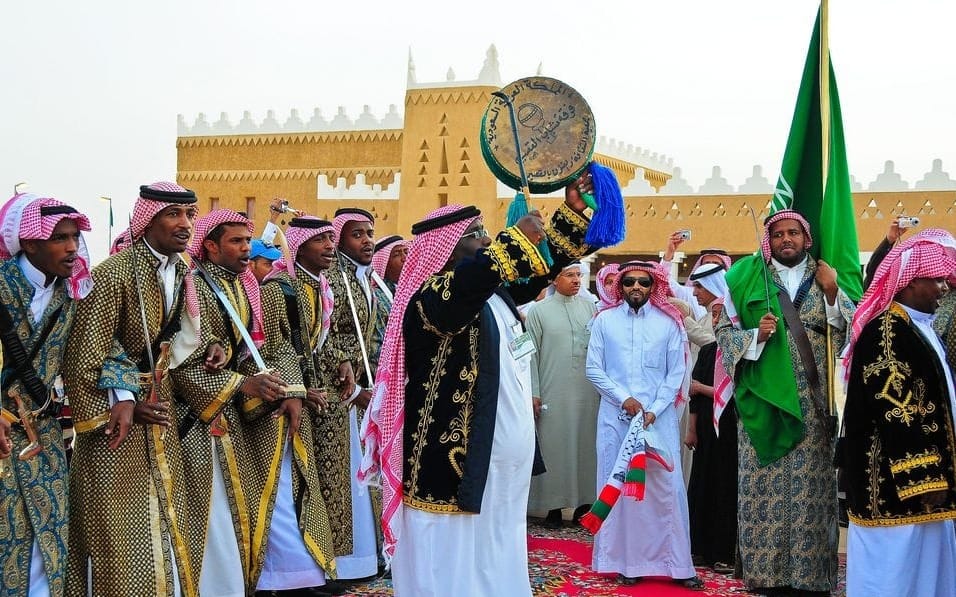Few cultural traditions command attention the way the Saudi Ardah does. With swords raised, drums pounding, and poetry echoing through the air, this iconic performance is a national statement. Rooted in centuries of heritage, the Ardah stands as one of Saudi Arabia’s most powerful symbols of identity and unity. Whether witnessed during a royal celebration or a local gathering, it leaves no doubt: this is a culture that remembers where it came from and carries it forward with pride.
What is the Traditional Ardah in Saudi Arabia?
The traditional Ardah in Saudi Arabia is a powerful performance art that blends poetry, rhythm, and coordinated movement. Known locally as Al-Ardah Al-Najdiyah (the Najdi Ardah), it originated in the central Najd region and has become a national symbol of unity and celebration. Today, it is performed during weddings, graduations, national holidays, royal ceremonies, and cultural festivals like Janadriyah. But its story begins far from the rhythm of drums and closer to the rhythm of war.
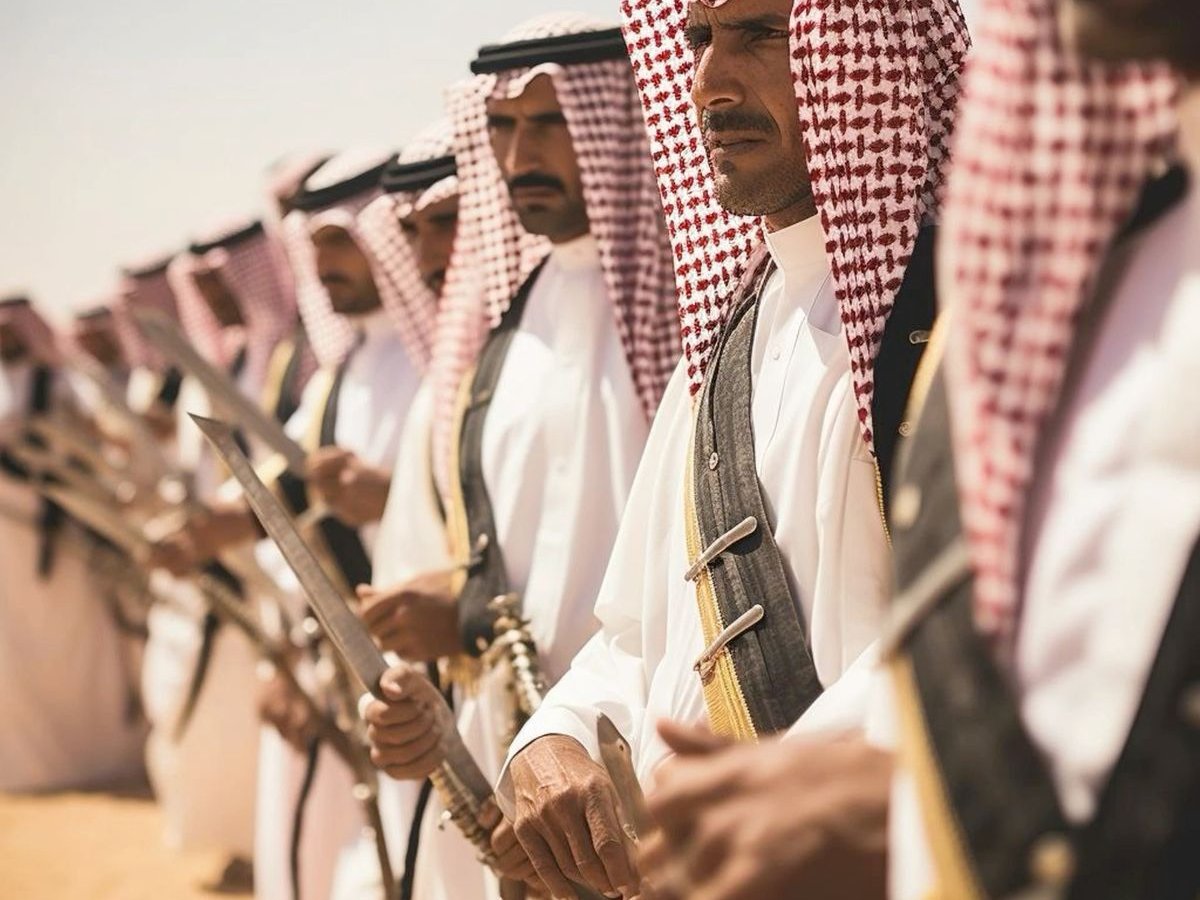
What is the Meaning of Al-Ardah?
The word Ardah comes from the Arabic verb arda, meaning "to show" or "parade." Historically, it was performed before battles, a way for tribes to showcase their strength, loyalty, and readiness to defend their land and leader. Warriors stood in lines, swords in hand, chanting verses of courage. It wasn’t just a performance; it was a declaration.
One of the earliest recorded Ardah performances took place in 1764, when Imam Abdulaziz Bin Mohammed Bin Saud led his army beyond the walls of Diriyah and performed the Ardah in front of enemy forces. From the battlefield to the festival grounds, Ardah has retained its essence: a proud display of unity, identity, and loyalty.
From War Cry to Celebration
As the Kingdom unified under King Abdulaziz, the Ardah transformed from war ritual to national treasure. Still performed with swords, chants, and drums, it became a way to celebrate peace, honor guests, and unite the people under one flag. King Abdulaziz himself often led the Ardah, banner in hand, surrounded by his soldiers. His successors, from King Saud to King Salman, have all performed it, sometimes alongside foreign dignitaries, sharing the joy of Saudi culture with the world.
In fact, it was King Abdullah who elevated its national importance. He designated a special day for the Saudi Ardah and supported its official recognition across the Kingdom. In 2015, the dance was inscribed by UNESCO as part of the Intangible Cultural Heritage of Humanity.
During official events, King Faisal would sometimes hand his own sword to visiting leaders and guide them through the steps himself. It was his way of sharing Saudi culture directly and respectfully.
What is the Sword Dance in Saudi Arabia?
The Saudi Ardah is often called the sword dance, and for good reason. At the heart of the performance is the sword, both symbol and tool. Traditionally thin, sharp, and light for agility, the sword is raised, rested, and swung in rhythm with drums and verse. Participants perform synchronized moves: swaying side to side, bending knees, lifting swords skyward. Sometimes they form two parallel lines, other times a semicircle or full circle, with a flagbearer standing proudly in the middle.

But it’s not just choreography. The swords carry the weight of history. Once wielded in defense, now they shimmer in celebration. Every movement is deliberate. Every stance speaks of pride, discipline, and continuity.
In some Ardah performances, men carry traditional pistols (Al-Fard) and rifles like Al-Jift and Umm Khams Talqat. While they’re always unloaded, the symbolism remains powerful, echoing the Ardah’s origins as a war dance.

How to Do Ardah?
Performing the Ardah is both an art and a ritual, involving poetry, music, costume, and movement. Here's how it unfolds:
- Hawrabah – A powerful voice begins the chant, usually two to three lines of poetic verse. This is the signal to align.
- Drums – Two types of drums follow:
- Takhmir (large drums) with single, thunderous beats.
- Tathlith (small drums) with fast, double beats. Together, they set the rhythmic foundation.
- Poetry – Nabati poems (up to 10 verses) describe bravery, loyalty, or even clouds and mountains, always ending with a message of strength.
- Movement – Men sway in rhythm, swords raised or resting on shoulders. Occasionally, they form a circle around the drummer or flag.
- Finale (Al-Zamiya) – Performers move toward their leader, chanting loyalty verses and ending with the phrase: “Tahta Bayraq Sayidi Sama’an Wa Ta’a” (Under the banner of my King, we heard and obeyed).
Women don’t participate in the physical performance, but they play a key role in crafting the costumes, embroidering jackets, and decorating the drums with tassels and colors, making sure the heritage is honored with every stitch.
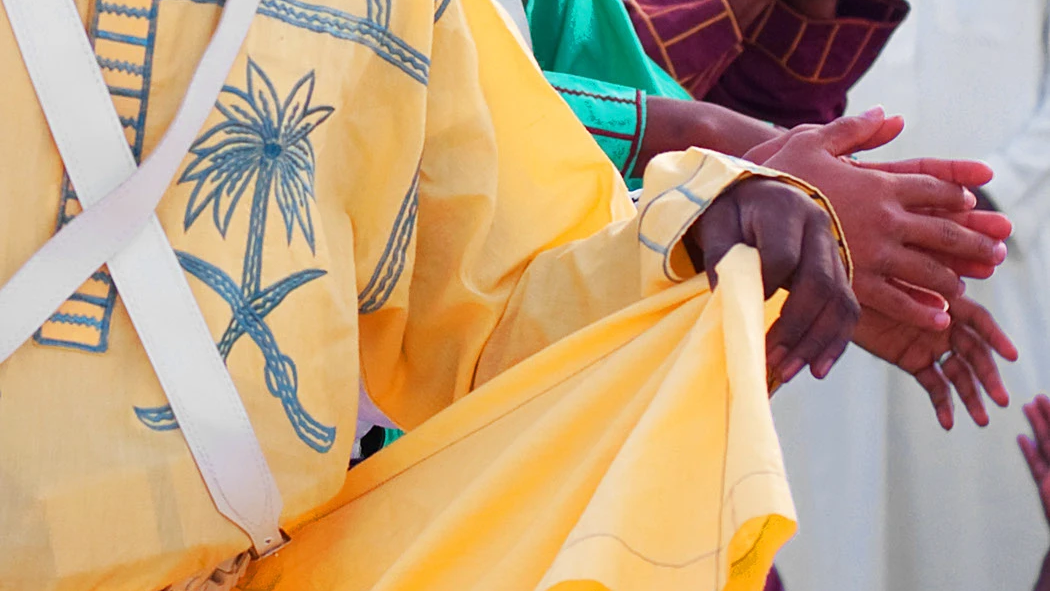
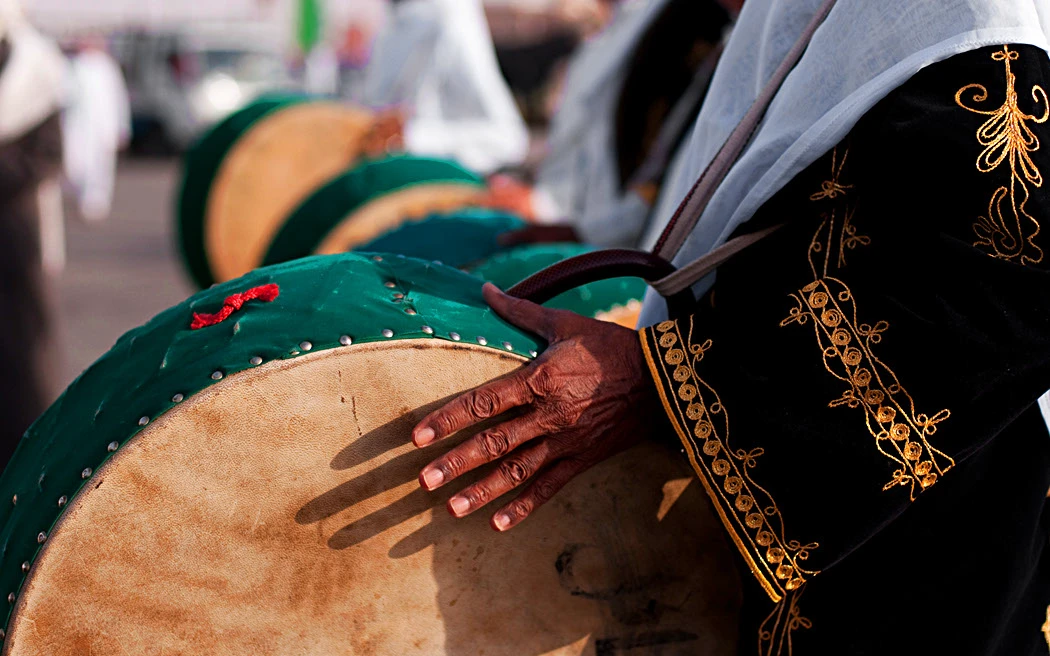
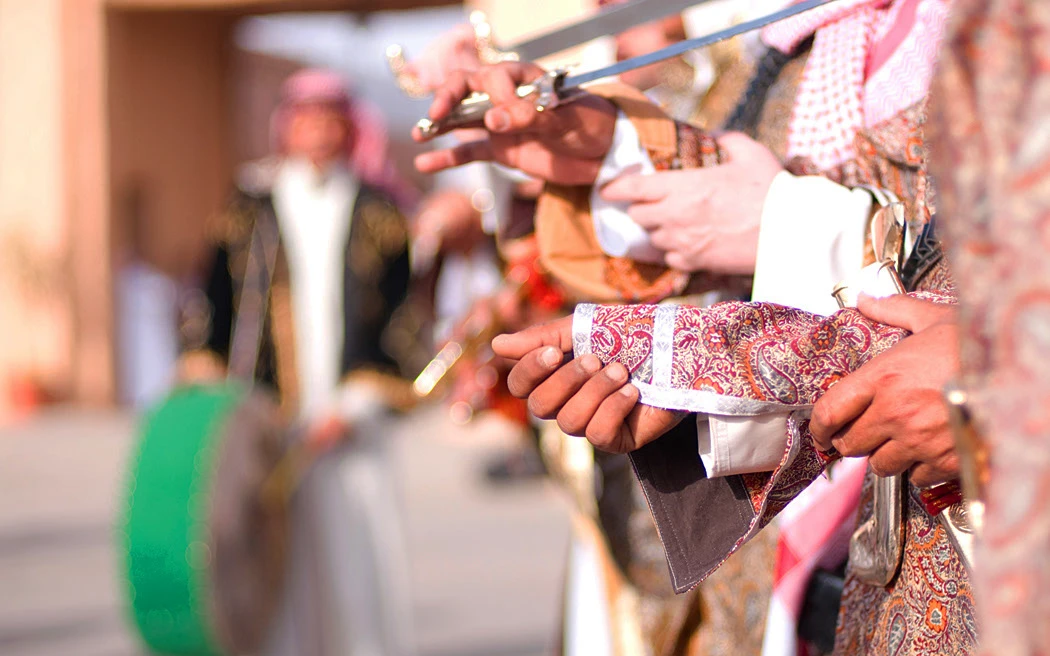
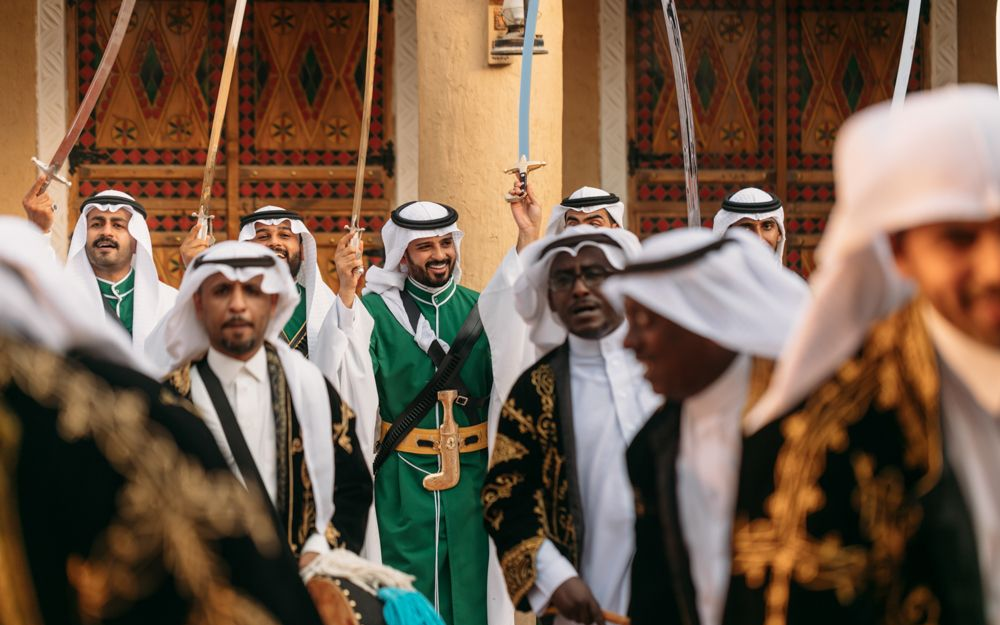
What is Al-Ardah Genre?
Al-Ardah is a genre of cultural expression. It belongs to a class of performing arts rooted in tribal tradition, fusing oral poetry, rhythmic drumming, military symbolism, and visual display. Within the genre:
- Music is percussive only. No melodic instruments are used.
- Poetry is central, often passed down through generations, acting as historical record.
- Costumes and weapons are symbolic: swords, daggers, pistols, rifles, each with specific meanings and rules for usage.
Its melodic tone is limited, often sticking to simple melody type (maqam) like Sika, rarely exceeding four notes. Why? Because Al-Ardah values the power of the word and the force of collective voice more than musical complexity. It’s closer to a national epic than a song.
Ardah poems often start by describing nature or calling the group to attention. But in some cases, they include light remarks aimed at rivals or enemies. It’s a poetic tradition that mixes humor, pride, and historical storytelling.
The Materials of Heritage
From headwear to heels, the Ardah costume is meticulously curated:
- Thobe, Ghutra, Egal – Base Saudi dress
- Murowdin – Wide-sleeved robe with belts for swords
- Daqlah – Embroidered coat with straight collars
- Farmliah – Wool coat with gold thread (for drummers)
- Jukha, Sayah, Zabon – Specialty robes, often in red, green, or black
Each item reflects a region, role, or rank. A reminder that heritage lives not only in movement, but in material.
As for the instruments, drums are made from palm wood and camel hide, their sides decorated with tassels and held with leather straps. Even the drumsticks are curved from bamboo for better rhythm. No tambourines, no strings, just the beating heart of tradition.
A Flag That Binds
No Saudi Ardah is complete without Al-Bairaq, the green flag identical to the national flag. It is carried by the flagbearer, often someone whose family held the flag in past wars. The flag never touches the ground, never folds, never fades. It stands tall in the center of the performance, flanked by drums and poetry, embodying all the pride and unity the Ardah represents.

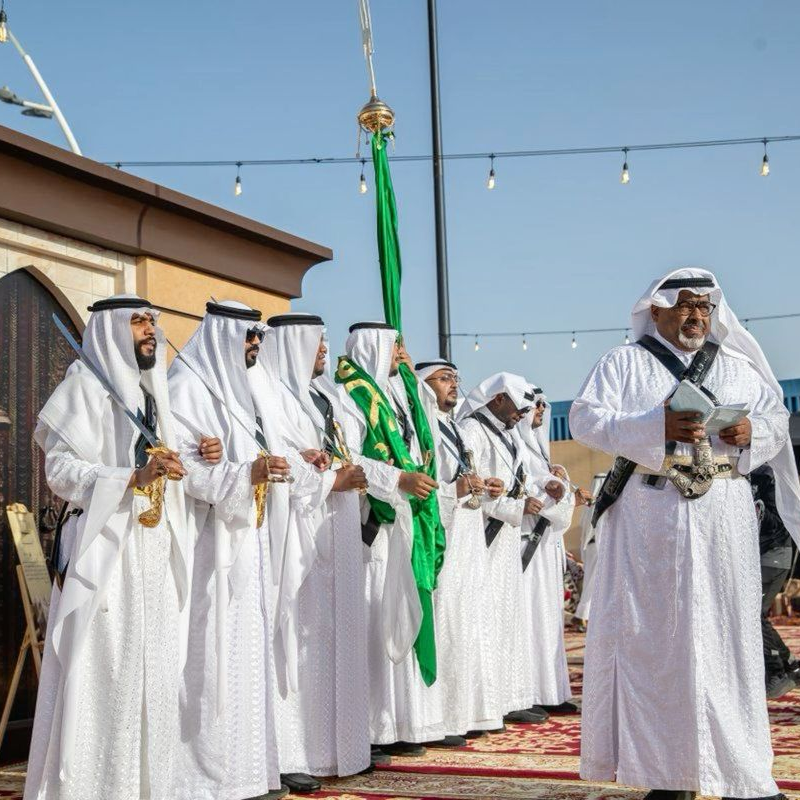
Institutions Preserving the Ardah
Saudi Arabia has taken major steps to protect and promote Ardah as a living heritage:
- National Center for Saudi Ardah: Oversees costume, rhythm, training, and public performance standards. Affiliated with the King Abdulaziz Foundation for Research and Archives (Darah).
- Diriyah Initiatives: Including Diriyah, Home of the Ardah (teaching children aged 8–16) and oral history documentation projects.
- Guinness World Record in Riyadh (2025) : The capital made history by hosting the largest recorded Ardah performance, with thousands participating in a coordinated display of national pride and cultural unity.
- Folklore Competitions: Launched by the Ministry of Culture to encourage community participation.
These efforts ensure that the Ardah remains not just a performance, but a living language of culture.
The Ardah Lives On
The Saudi Ardah is a breathtaking blend of form and feeling, of discipline and expression, of individual role and collective meaning. It’s not just a sword dance. It’s a story, a legacy, a rhythm passed from fathers to sons, from leaders to people. And today, whether you're a local rediscovering your roots or an expat exploring Saudi culture for the first time, the Ardah offers something unforgettable.
It’s not just something you watch. It’s something you feel deep in your chest, beating with the drums.
Curious for More Cultural Gems Like This?
Subscribe to Saudi Cultures for deep dives into traditions, regional stories, and voices from across the Kingdom.
